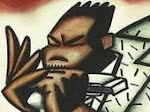
 Sin duda, uno de los más brillantes e influyentes instrumentistas de los prodigiosos años 20, la guitarra de Arthur 'Blind' Blake fue uno de los secretos mejor guardados de la música americana hasta finales de los 60 y primeros 70, cuando guitarristas como Jorma Kaukonen, Ry Cooder o Stefan Grossman, entre otros, se ocuparon de hacerle justicia y también de divulgar sus trucos entre los aficionados (pero ya hacía algunos años que maestros como Reverend Gary Davis o el virginiano John Jackson se ocupaban de mantener vivo su legado). Blake forma, junto a Lonnie Johnson y Eddie Lang, el triunvirato de oro de la guitarra americana en la década de los 20, y sus discos resultan no sólo indispensables para cualquier aficionado o profesional de la guitarra acústica, sino que son también posiblemente los que ofrecen mayor variedad y consistencia, y los más asequibles del blues de pre-guerra (comparado con Lonnie Johnson, por ejemplo, otro maestro, vemos hasta qué punto la música de Blake admite ser disfrutada en antologías amplias y no sólo en el formato original de dos caras a 78 rpm).
Sin duda, uno de los más brillantes e influyentes instrumentistas de los prodigiosos años 20, la guitarra de Arthur 'Blind' Blake fue uno de los secretos mejor guardados de la música americana hasta finales de los 60 y primeros 70, cuando guitarristas como Jorma Kaukonen, Ry Cooder o Stefan Grossman, entre otros, se ocuparon de hacerle justicia y también de divulgar sus trucos entre los aficionados (pero ya hacía algunos años que maestros como Reverend Gary Davis o el virginiano John Jackson se ocupaban de mantener vivo su legado). Blake forma, junto a Lonnie Johnson y Eddie Lang, el triunvirato de oro de la guitarra americana en la década de los 20, y sus discos resultan no sólo indispensables para cualquier aficionado o profesional de la guitarra acústica, sino que son también posiblemente los que ofrecen mayor variedad y consistencia, y los más asequibles del blues de pre-guerra (comparado con Lonnie Johnson, por ejemplo, otro maestro, vemos hasta qué punto la música de Blake admite ser disfrutada en antologías amplias y no sólo en el formato original de dos caras a 78 rpm).Las grabaciones de Blind Blake (1926 a 1932) han ido siendo oportunamente recuperadas por las compañías Biograph, Yazoo y Document, entre otras, y más recientemente, en una integral de 5 CDs por el sello JSP, reconocidos expertos en remasterización de joyas vintage de jazz y blues.
-Jay Bee Rodríguez
01. Blind Arthur's Breakdown
02. C.C. Pill Blues
03. Black Biting Bee Blues (vo by Leola B. Wilson)
04. Hard Pushing Papa
05. Black Dog Blues
06. Georgia Bound
07. Hastings Street (with Charlie Spand, pno)
08. Skeedle Loo Doo Blues
09. Rope Stretching Blues
10. Chump Man Blues
11. Diddie Wa Diddie
12. Sweet Jivin' Mama
13. Itching Heel (vo by Irene Scrugs)
14. Too Tight Blues No. 2
15. Southern Rag
16. One Time Blues
17. Playing Policy Blues
18. Hey Hey Daddy Blues
19. Sweet Papa Low Down
20. Police Dog Blues
21. Wilson Dam (vo by Leola B. Wilson)
22. Come On Boys, Let's Do That Messin' Around
23. You Gonna Quit Me Blues
24. Let Your Love Come Down (vo by Bertha Henderson)
25. Bad Feeling Blues
26. Righteous Blues
27. Down The Country Blues (vo by Bertha Henderson)
28. Seaboard Stomp
hotjazzandcoolblues
............................
Police Dog Blues
by Blind Blake
This is Blake's only song in open E tuning (that I know of)
Ry Cooder does a faithful rendition on his eponymous first album, and
Jorma Kaukonen does good versions on "Splashdown" and "Quah". Cephas
and Wiggins do an interesting interpretation on "Guitar Man" and
Stephan Grossman has a few versions out.
Open E tuning: EBEG#BE (open D also works)
These are the main chords:
E A E/C# E/C B
-----0----------0----------0-------------0-----------0---------
-----0----------2----------0-------------0-----------0---------
-----0----------1----------3-------------2-----------1---------
-----0----------0----------4-------------3-----------2---------
-----0----------2----------------------------------------------
-----0---------------------------------------------------------
harm.
(12)-------------(12)--------------|--------2------------------------
----(12)-------------(12)----------|-----0-----3-(4)---0-----------
--------(12)-------------(12)------|---------------------------------1
------------(12)-------------(12)--|----------------------------------
-----------------------------------|--0--------------------0--1--2--
-----------------------------------|-------------------------------
(2X) Verse: All my life I've been a travelin man
-0----------------------------||---0-------0--------------------------
-----3--2---0-----------------||--------0------------2-----------------
----------------------0-------||--------------------------1-----------
--------------0----3------0---||------0------0-----------------0----0--
------------------------------||-------------------2--------2--------
------------------------------||--0-------0-----------------------0--
All my life I've been a travelin
--0--------------------0--------0-------------------------------------
-----3--2--0-------------3-(4)-----2---------2--------2------------
--------------------0----------------------1--------1----------1------
------------0---3------0---------------0--------0---------0---------
----------------------------------2---------2--------2---------2------
-------------------------------------------------------------------------
man * Stayin' alone and doin' the best I can
---|-0-----------------------------------0-----------------0--------0------
---|----3--2--0--------------------------0-----------------0--------0------
---|--------------0------1----2-------3-----------------2--2-----1-------0-
---|----------0--3---0---2----3-------4-----------------3--------2-------0-
---|-----------------------------------------------------------------------
0--|--------------------------------------------------------------------0--
1st break (2X) harm.
--------7---------------9---||----------(12)-----------------(12)---
-8-(9)---------8-(9)--------||----------------(12)------------------
----------------------------||---------------------(12)-------------
-----------0---------------0||-0------------------------(12)--------
----------------------------||--------------------------------------
-0----------------------0---||----0---------------------------------
--------------------0----3-(4)--0------3p2p0----------0------------
-(12)---------------2--2------------------------2-------0---------
-----(12)--------1-------------------1-----------------------0-----
----------0-----------------------0-------------0----------3----0--
------------1h2---------2-------------2----------------0----------
-------------------------------------------------------------------
return to *
2nd break
-----------------------||--------------------------------------------
-----------------------||--------------------------------------------
------0--1---2---3---0-||----0-1--2--3--0---1--2--3--0--0---0---etc.-
----0----2---3---4---0-||--0---2--3--4--0---2--3--4--0--0---0--------
-----------------------||--------------------------------------------
-----------------------||--------------------------------------------
3rd break
-------------------------------------------------0---------------------
-----------------------------------------------------3--2--0-----------
------------------------------------------------------------------0-etc.
---------------------------------------------------------------3-------
---0----0----0----0----0----0----0-----0------0------------------------
-0----2----3----4----0----2----3----4------0---------------------------
4th break (4X)
-(12)-------------------||----------0------3---0-------3-2--0----0-
------(12)--------------||------------------------------------2----
-----------(12)---------||-------1--1---1-----------1--------------
-----------------(12)---||------------------------0-----------0----
------------------------||-1--2------------2-----------------------
------------------------||-----------------------------------------
-------------------0------------------------------------------------
--0-------------------3--2--0---------------------------------------
-------0---------------------------0------you get the idea----------
-----3--------------------------3-----0-----------------------------
--0-------0-----------------0---------------------------------------
---------------0----------------------------------------------------
Transcribed by MaxxDaddy
.........................................
Blind Arthur's Breakdown
by Blind Blake
Intro:
C A7 D7 G7 C A7 D7 G7
-2--3--4--3--2----0-----3---2----1----0----3----2----1-
-1--2--3--2--1----1-----2---1----0----1----2----1----0-
-1--2--3--2--1----0-----2---2----0----0----2----2----0-
-1--2--3--2--1----2-----2---0----0----2----2----0----0-
----------------3----0--------------3----0-------------
--------------------------2----3--------------2----3---
4x
---0----0----3--3--0-1-2----------3--1----0--||----0-----0-||
---1--4------2--2------1--------0---------1--||----3-----1-||
---0------------2-------------3---------0----||------------||
-----------------------0----------------2----||----2-----2-||
-3---------0--------------------------3------||-------0----||
-------------------2------3------------------||--0---------||
------------3-1---------0-3-1--------5--3---2----------------------------
--------------------0-3---------1----2------1----0---1--2--3---3---2--1--
---------0------0-3-------------0----2-----------0--2--3--4--------------
---------0----------------------2----2------0----------------------------
---0-1-2----------------------3----0-------------------------5---4--3--2-
-3----------------------------------------2----3-------------------------
-3--1----------0-3-------------2----------3--2---1--1--3-2-1-0-
-----------0-3---------3----1--1----------2--1---3--3--------1-
-------0-3-------------1----2--1-------------2---------------0-
----------------------2-----3--1-----------------------------2-
----------------------------3-----3-2-1-0--------------------3-
-------------------0------1------------------------------------
---2-2---3-3--2----1-------------------------------0---0-
---1-1---2-2--1----0--0---------------------3---3--1---1-
--------------------------------------------3---3--3---3-
-1-----2--------0--------------0-3-0---------------------
---------------------------0-3-------3-0--1-------3------
--------------2----3-----1--------------------1------3---
----------------------2--1-1-3-1------------2----0----3--2--1--1-
----------------------1-----------1-----1---1----1----2--1--0--0-
----------------------2-----------3-----2---1----0----2--2-------
---------0-3-3-2-1--0-------------2-----3---1----2------------0--
-----0-3-------------------------3-------------3----0------------
-1-1---------------------3------------1-----------------2---3----
-3---3/5--1-----3/5--1-----0--3/5-0--4--5-3--2--------------------
---------------------------1-----------------1---0-1-2-3--3-2-1-0-
---------------------------0---------------------0-2-3-4----------
---0---------0------0------------------------0--------------------
-------------------------3--------------0-----------------5-4-3-2-
-3--------3-----3-------------3------0------2---------------------
---1-----------0--------------2----3-0----3--2---1--------------------
---0------1--4-----3-----2----1----1------2--1---0--------------------
-------------------1-----3----2-----------2--2---0--------------------
---0------2--------2-----3------0-------------------1-0---1-0---1-0---
--------3--------------------------3----0---------------3-----3-----3-
-3----3----------0-----1----2---------------2--3----------------------
----------------------------3--1-------0-3-1---0------------------3-
-0--1--2-0--0-0--1--2--3-0----------0-3--------1------------------2-
-0-2--3--0--0-0-2--3--4--0-------0-3-----------0------------------2-
-------------------------------0------0-------------------------0---
---------------------------------------------3----0-1-2--0-1-2------
----------------------------3--------------------------3------3-----
---2-----------3---------------------0----------0----
---1--0--1--2--0-----8---8--7-6-5----5----------5----
---------------0---0---0-----------------------------
---0---------------------------------6---6~----7---7-
------3--2--1-----10--10---9--8-7--7---------0-------
-2-------------3-----------------------7--------0----
----------------------------------------3----1---3-0---------0-
-----------------------------------------------0-----1--1-1--1-
-----------------------------------------------------0--1-1--0-
---------------------0-3-4--0-3-4-------0----0----------1-1--2-
-0-3-4--0-3-4--0-3-4--------------0-1-2--------------3-------3-
-------------------------------------------3-------------------
Transcription by Max Daddy.



























